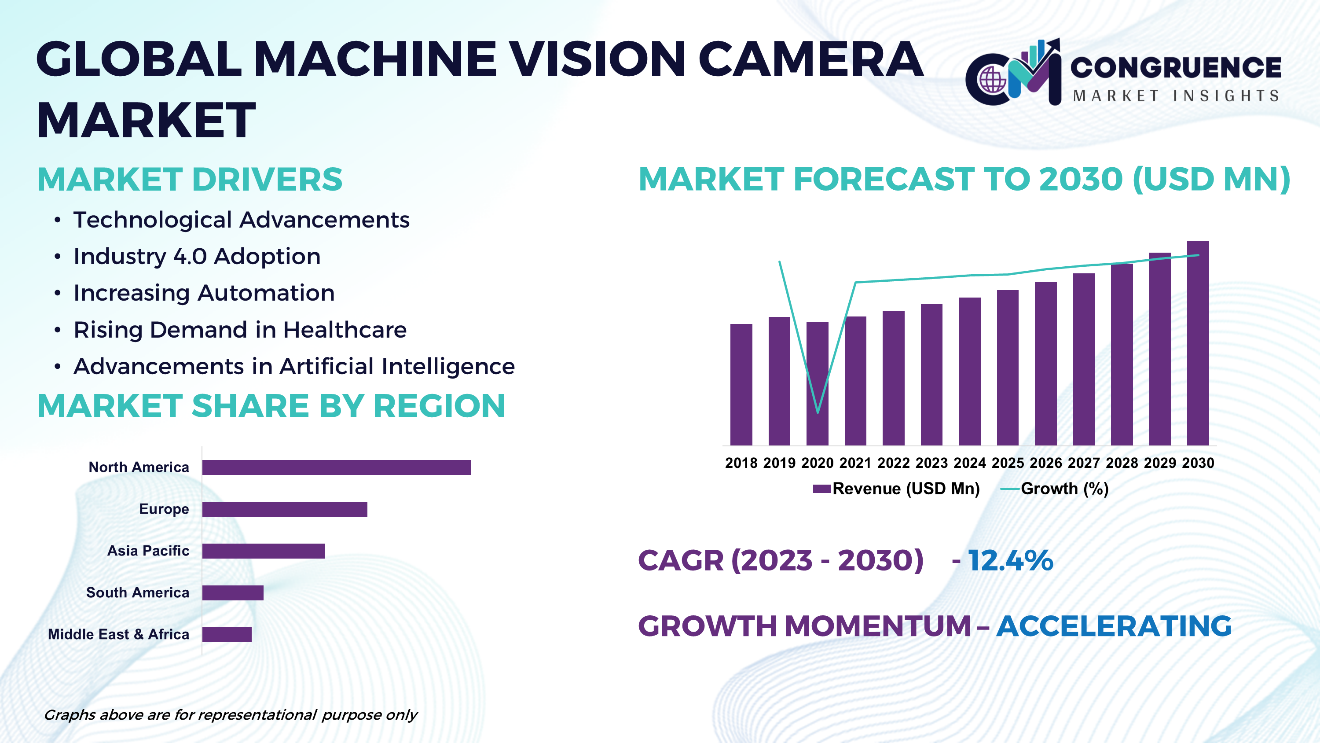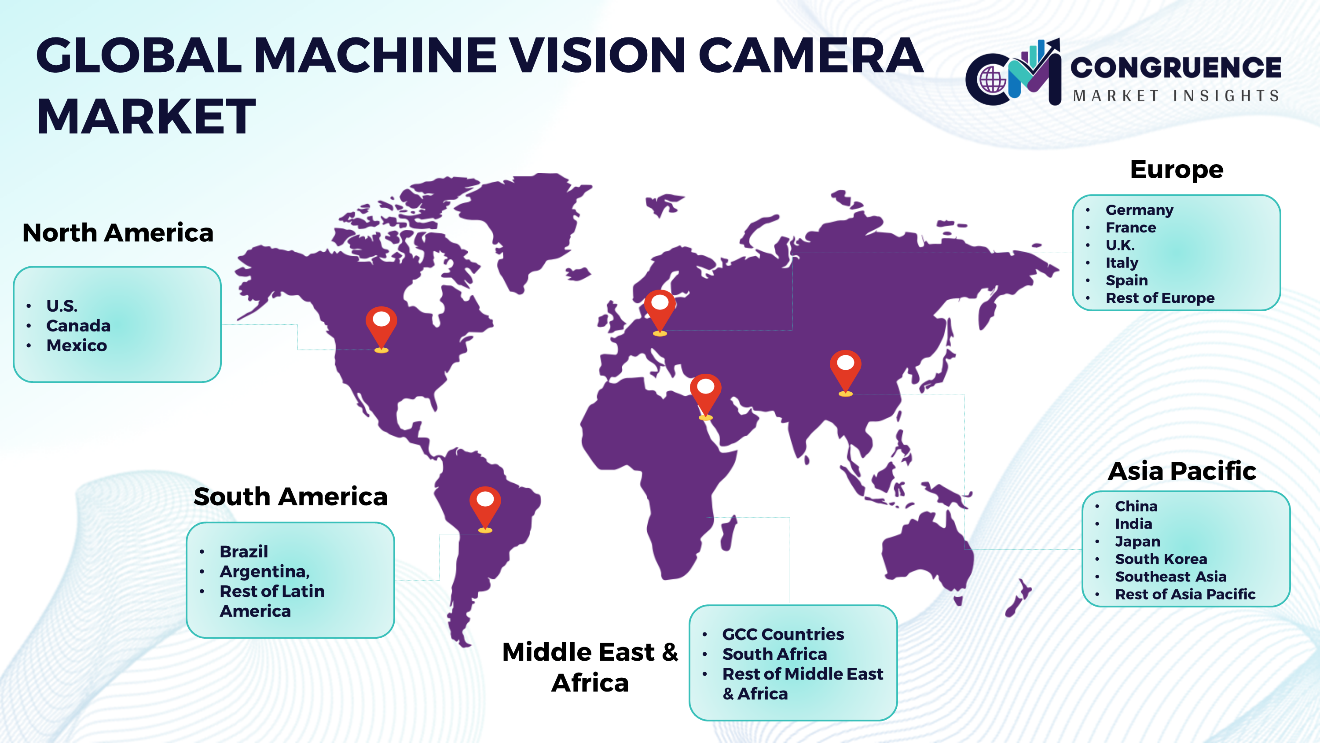Reports
The Global Machine Vision Camera Market is expected to expand at a CAGR of 12.4% between 2023 and 2030. Machine vision cameras, propelled by state-of-the-art technology, are poised to redefine various industries with their advanced functionalities. Leveraging high-resolution sensors, artificial intelligence algorithms, and edge computing capabilities, these cameras excel in tasks such as quality control, object recognition, and automation. The increasing integration of Internet of Things (IoT) solutions further augments the applicability of machine vision, facilitating seamless data exchange and remote monitoring across sectors such as manufacturing, healthcare, and smart infrastructure. This convergence contributes significantly to enhancing production efficiency, ensuring product quality, and promoting operational safety. Within the market landscape, machine vision cameras are experiencing surging demand, fueled by the advent of Industry 4.0 initiatives, automation trends, and the relentless pursuit of precision across diverse industries.

Machine Vision Camera Market Major Driving Forces
Technological Advancements: Continuous innovation in sensor technology, image processing algorithms, and hardware components enhances the performance and capabilities of machine vision cameras, enabling higher accuracy and faster processing speeds.
Industry 4.0 Adoption: The integration of machine vision cameras with Industry 4.0 initiatives, such as smart manufacturing and automation, fuels demand for advanced imaging solutions to optimize production processes, ensure quality control, and enhance efficiency.
Increasing Automation: The escalating trend towards automation across industries necessitates the use of machine vision cameras for tasks such as robotic guidance, inspection, and monitoring, driving market growth.
Rising Demand in Healthcare: The healthcare sector increasingly relies on machine vision cameras for medical imaging, diagnostics, and patient monitoring applications, driving market expansion in areas such as telemedicine and medical device manufacturing.
Advancements in Artificial Intelligence: Integration of machine vision cameras with artificial intelligence and deep learning technologies enhances their capabilities for pattern recognition, object detection, and image analysis, opening up new applications and markets.
Machine Vision Camera Market Key Opportunities
Integration with Industry 4.0: The integration of machine vision cameras with Industry 4.0 initiatives heralds opportunities for enhanced automation, predictive maintenance, and real-time quality control in manufacturing processes.
Advancements in Healthcare: Within the healthcare sector, machine vision cameras offer avenues for advanced medical imaging, telemedicine applications, and personalized patient care, fostering innovation and augmenting healthcare outcomes.
Robotics and Automation Advancements: Machine vision cameras enable advancements in robotic guidance, inspection, and automation applications, fostering increased productivity and efficiency in manufacturing and logistics operations.
Integration with Edge Computing: The integration of machine vision cameras with edge computing technologies presents opportunities for real-time data processing and analysis at the network edge, enhancing decision-making speed and reducing reliance on centralized processing.
Remote Monitoring Solutions: Machine vision cameras offer opportunities for remote monitoring and surveillance applications in domains such as home security, environmental monitoring, and infrastructure inspection, delivering real-time insights and bolstering situational awareness.
Autonomous Systems Development: Machine vision cameras facilitate the development of autonomous systems across sectors such as transportation, agriculture, and retail, presenting opportunities for heightened efficiency, safety, and productivity.
Machine Vision Camera Market Key Trends
· Advancements in sensor tech and image processing refine machine vision camera capabilities, enhancing resolution and processing speed.
· Integration with AI enables features like object detection and predictive maintenance, expanding applications and boosting efficiency.
· Rapid uptake in Industry 4.0 drives demand for automation and real-time monitoring in manufacturing and logistics.
· Expansion into sectors like healthcare and agriculture diversifies applications, from medical imaging to inventory management.
· Edge computing integration enables real-time data analysis, reducing latency for applications like autonomous vehicles.
· Demand rises for compact, portable solutions for field inspections and wearable devices.
· Focus on sustainability drives adoption in quality control and waste reduction efforts.
· Integration with wireless tech like 5G ensures seamless connectivity, enhancing productivity.

Market Competition Landscape
The competitive landscape within the machine vision camera market is marked by robust competition among manufacturers and technology firms. Key determinants shaping market dynamics encompass technological innovation, differentiation in product offerings, and strategic pricing approaches. Furthermore, the escalating demand for tailored solutions tailored to specific industries amplifies competitive pressures. Strategic partnerships and collaborative ventures are commonly adopted strategies as enterprises endeavor to secure market dominance and capitalize on emerging prospects across diverse sectors.
Key players in the global Machine Vision Camera market implement various organic and inorganic strategies to strengthen and improve their market positioning. Prominent players in the market include:
· Cognex Corporation
· Keyence Corporation
· Basler AG
· Omron Corporation
· Teledyne Technologies
· National Instruments Corporation
· Sony Corporation
· Texas Instruments Incorporated
· Intel Corporation
· Sick AG
· TKH Group
· Micron Technology
· ASML
· Samsung
· Synopsys
· KLA
· Atlas Copco
· Microsoft
· Marvell Technology Group
· NXP Semiconductors
|
Report Attribute/Metric |
Details |
|
Base Year |
2022 |
|
Forecast Period |
2023 – 2030 |
|
Historical Data |
2018 to 2022 |
|
Forecast Unit |
Value (US$ Mn) |
|
Key Report Deliverable |
Revenue Forecast, Growth Trends, Market Dynamics, Segmental Overview, Regional and Country-wise Analysis, Competition Landscape |
|
Segments Covered |
· By Component (Hardware (Vision Systems, Cameras, Optics And Illumination Systems, Frame Grabbers, and Others), and Software) · By Deployment (General and Robotic Cells) · By Product Type (PC-based Machine Vision System and Smart Camera-based Machine Vision System) · By Application (ProductInspection, Object Detection and Tracking, Defect Detection, Robot Guidance, and Quality Control, and Others) · End-use Industry (Food and Beverage, Healthcare and Pharmaceutical, Logistics and Retail, Automotive, Electronics and Semiconductor, and Others) |
|
Geographies Covered |
North America: U.S., Canada and Mexico Europe: Germany, France, U.K., Italy, Spain, and Rest of Europe Asia Pacific: China, India, Japan, South Korea, Southeast Asia, and Rest of Asia Pacific South America: Brazil, Argentina, and Rest of Latin America Middle East & Africa: GCC Countries, South Africa, and Rest of Middle East & Africa |
|
Key Players Analyzed |
Cognex Corporation, Keyence Corporation, Basler AG, Omron Corporation, Teledyne Technologies, National Instruments Corporation, Sony Corporation, Texas Instruments Incorporated, Intel Corporation, Sick AG, TKH Group, Micron Technology, ASML, Samsung, Synopsys, KLA, Atlas Copco, Microsoft, Marvell Technology Group, and NXP Semiconductors |
|
Customization & Pricing |
Available on Request (10% Customization is Free) |
